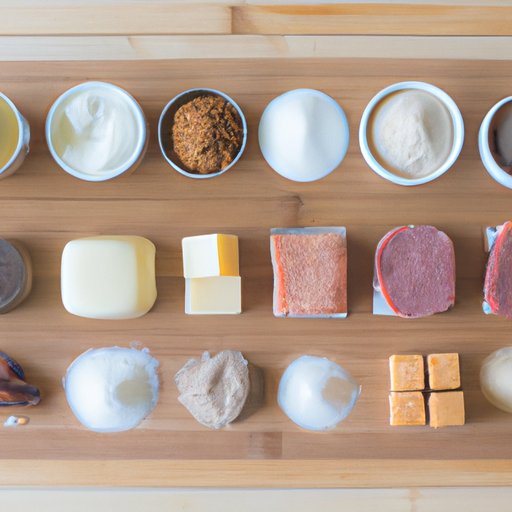
I. Introduction
Are you wondering how to get more protein in your diet? You’re not alone! Protein is essential for our bodies to function properly, and not getting enough of it can lead to fatigue, weakness, and poor recovery after exercise.
II. Benefits of Protein
Protein is an essential macronutrient that plays an important role in the body. It helps build and repair tissues, including muscles, bones, and even skin. In addition, protein helps maintain a strong immune system and aids in the production of enzymes and hormones.
Research shows that a diet high in protein can also lead to weight loss, increased muscle mass, and reduced blood pressure. For example, a study published in the American Journal of Clinical Nutrition found that increasing protein intake by just 15% resulted in significant weight loss and reduced cravings for late-night snacking.
III. High Protein Foods
There are many high-protein foods you can easily add to your meals and snacks. Here are some examples:
- Chicken breast (31g of protein per 100g)
- Tuna (30g of protein per 100g)
- Eggs (13g of protein per 2 large eggs)
- Chickpeas (8g of protein per half cup)
- Quinoa (4g of protein per half cup)
There are also meatless protein sources for vegetarians and vegans, such as tofu, tempeh, and legumes. These foods are not only high in protein, but also rich in fiber, vitamins, and antioxidants.
IV. Protein Powder in Smoothies
One convenient way to increase your protein intake is by adding protein powder to smoothies. Protein powder can be made from a variety of sources, such as whey, casein, soy, and pea protein.
When choosing a protein powder, make sure to look for high-quality brands that are low in added sugars and artificial ingredients. You can also experiment with different flavors and blends to find the one that suits your taste preferences.
Here is a delicious and healthy smoothie recipe that is high in protein:
- 1 scoop vanilla protein powder
- 1 banana
- 1 cup unsweetened almond milk
- 1 tablespoon chia seeds
- 1 teaspoon honey (optional)
V. Meal Planning and Prepping
Meal planning and prepping are key to ensuring that you have protein-rich foods available throughout the week. Try these tips:
- Plan your meals ahead for the week
- Cook in bulk on Sundays or another convenient day
- Portion out meals in containers for easy grab-and-go lunches
- Stock up on high-protein snacks, such as jerky, nuts, and seeds
Here is a simple and tasty recipe for meal prep:
- 1 pound ground turkey
- 1 tablespoon olive oil
- 1 yellow onion, chopped
- 2 garlic cloves, minced
- 1 red pepper, chopped
- 1 can black beans, drained and rinsed
- 1 cup cooked quinoa
- 1 tablespoon chili powder
- 1 teaspoon ground cumin
- Salt and pepper to taste
VI. Creative High-Protein Recipes
Getting more protein in your diet doesn’t have to be boring! Here are some creative and tasty recipes to try:
Breakfast
- Protein pancakes made with Greek yogurt and rolled oats
- Avocado toast with a boiled egg on top
- Smoothie bowl topped with nuts, seeds, and fruit
Lunch
- Turkey and avocado wrap with spinach and hummus
- Tuna salad with Greek yogurt instead of mayo
- Quinoa and vegetable stir-fry with tofu or tempeh
Dinner
- Baked chicken with roasted vegetables
- Grilled fish with a side of quinoa or brown rice
- Beef and broccoli stir-fry with brown rice
Snacks
- Cottage cheese with fruit and nuts
- Hard-boiled egg with a slice of cheese
- Edamame with sea salt and red pepper flakes
VII. Portion Control and Balancing Macronutrients
While it’s important to get enough protein, it’s also important to make sure you’re not overdoing it. Too much protein can put a strain on your kidneys and contribute to dehydration and fatigue.
Aim to consume 0.8 grams of protein per kilogram of body weight per day. This translates to about 56 grams per day for the average sedentary man and 46 grams per day for the average sedentary woman.
It’s also important to balance your protein intake with other macronutrients, such as carbohydrates and fats. A balanced meal should include all three macronutrients.
VIII. Conclusion
In conclusion, getting more protein in your diet can have numerous benefits for your health and wellness. By including high-protein foods in your meals and snacks, adding protein powder to smoothies, planning and prepping your meals, and trying creative protein-rich recipes, you can easily increase your protein intake.
Remember to practice portion control and balance your macronutrients for a healthy and balanced diet.




